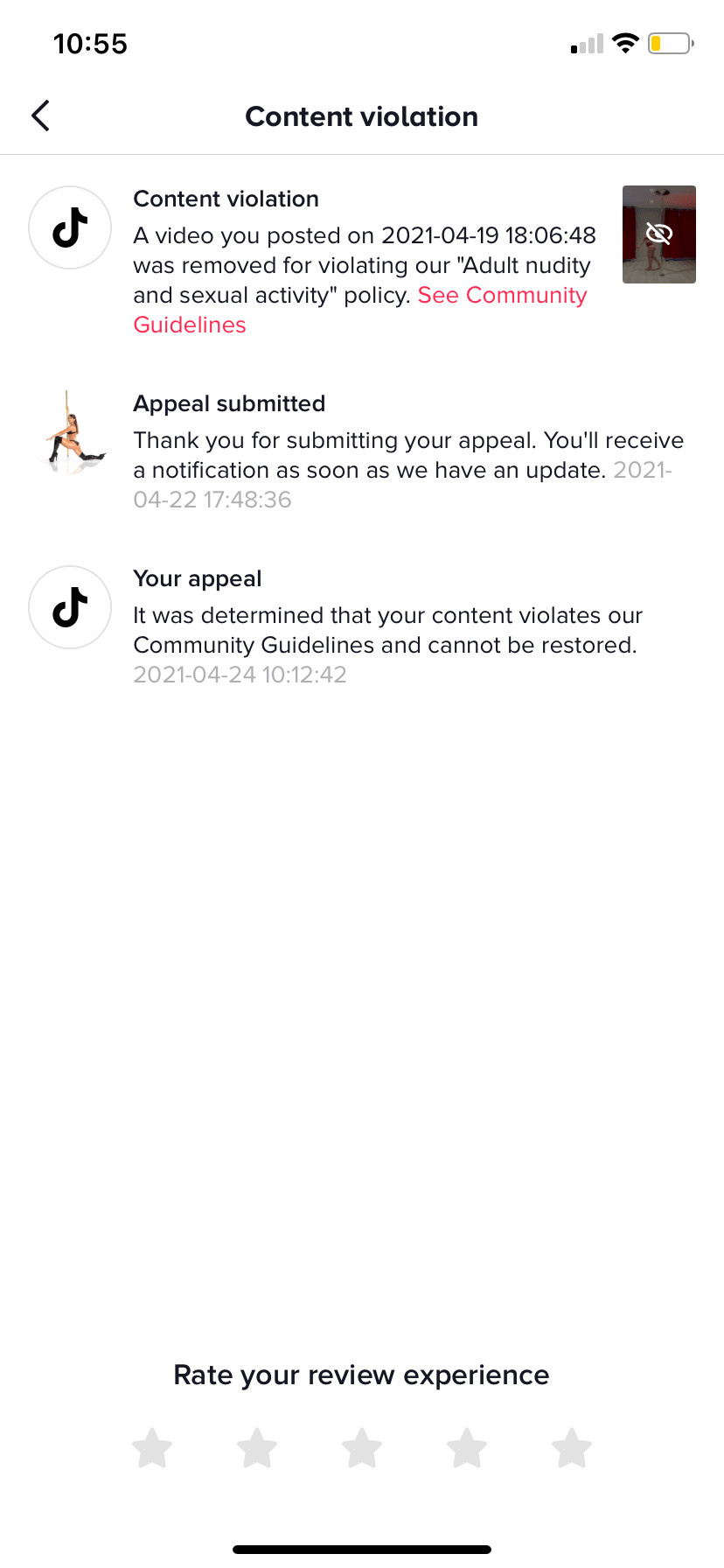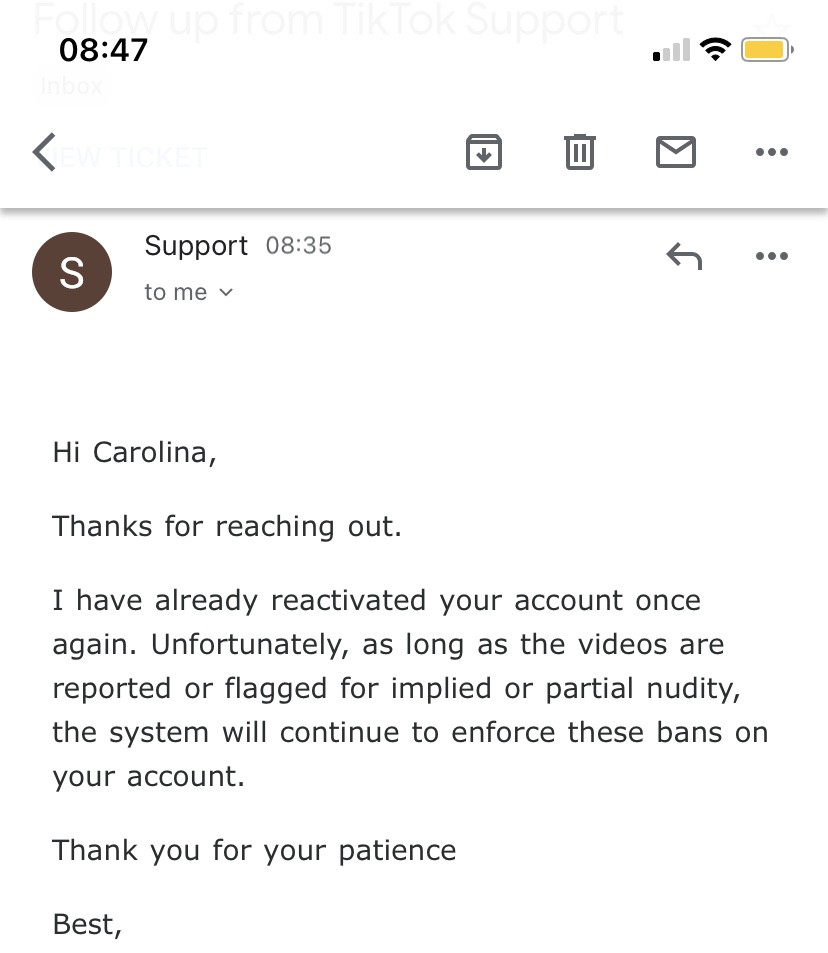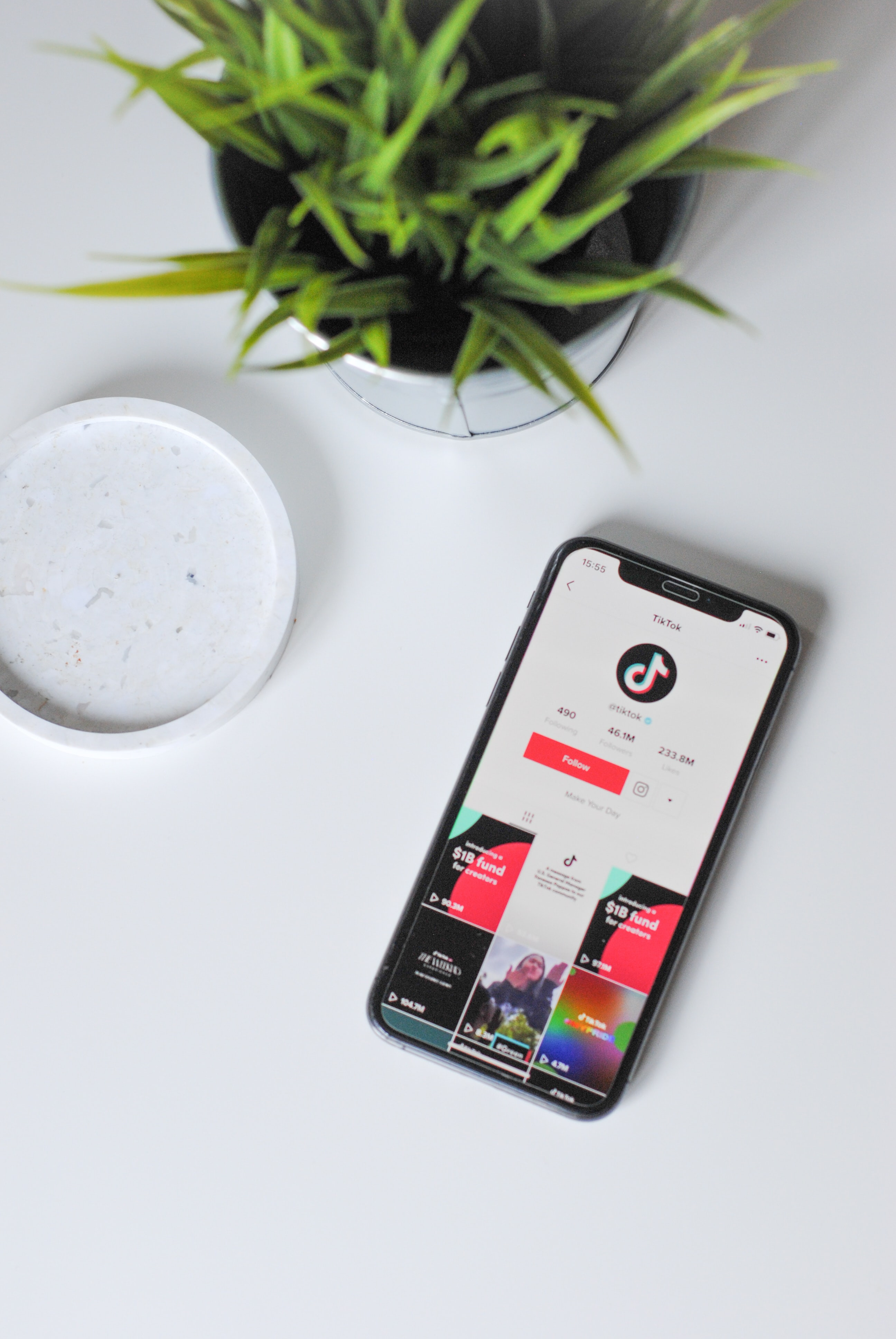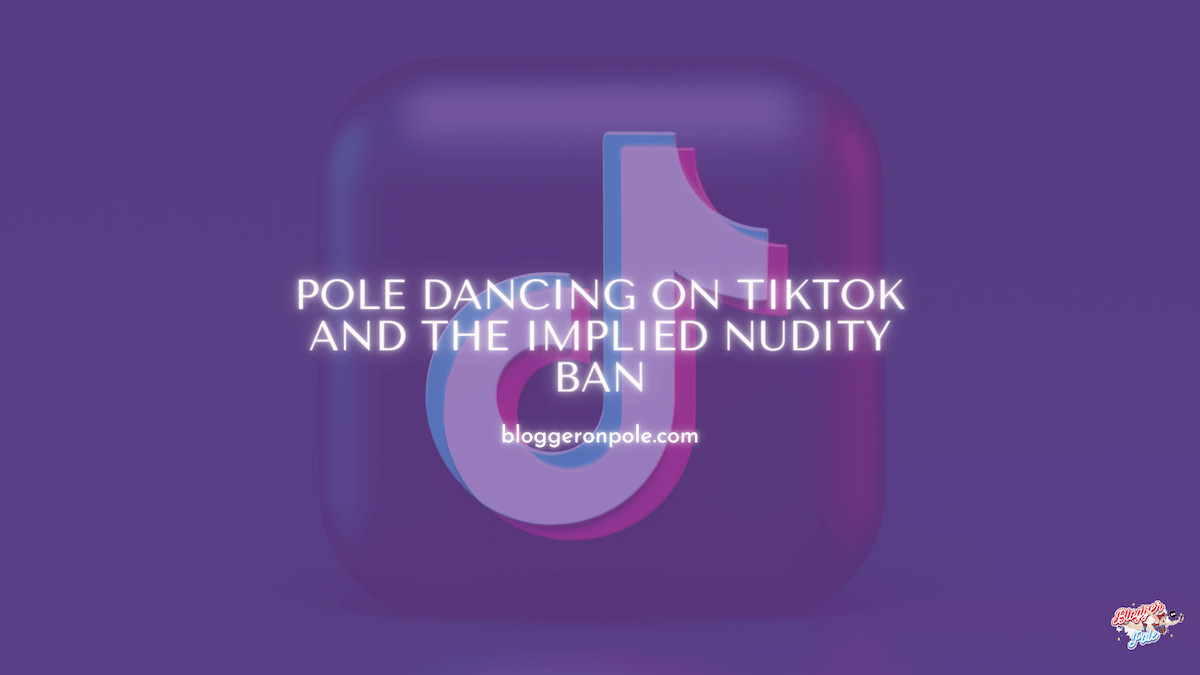Social media platforms like TikTok have become vital spaces for self-expression and community building, especially for dancers. However, for pole dancers on TikTok, sharing their art is increasingly fraught with challenges, particularly concerning content moderation and the platform’s stance on “implied nudity.” My experience as a pole dancer and content creator on TikTok in 2021 highlights the growing difficulties and inconsistencies in content governance, raising important questions about censorship and freedom of expression online.
It’s crucial to acknowledge that my struggles with TikTok’s moderation are part of a broader pattern of online censorship, disproportionately affecting marginalized communities. As noted by numerous writers, sex workers have long faced platform removals, demonstrating a shrinking online space for discussions around nudity, sexuality, and sex work. The censorship faced by sex workers eventually trickles down, impacting even seemingly less explicit content like pole dancing. Therefore, advocating for a more inclusive online environment for sex workers is essential for ensuring a safer and more inclusive space for everyone.
My personal journey with TikTok began positively. Starting in January 2020, I quickly gained 8,000 followers, seemingly effortlessly. My content, showcasing pole dancing routines and fitness, resonated with a growing audience. However, as TikTok’s popularity surged, particularly during lockdown periods, its moderation policies became noticeably stricter, especially regarding nudity and related content.
My initial viral moment in February, reaching 70,000 followers, ironically triggered a wave of negative attention. Users who disliked my content, deeming it inappropriate for TikTok, began mass-flagging my videos in an attempt to curate their feeds.
@bloggeronpoleThis week I became a ##dr in ##criminology & a ##poledancer ##WAP – With A ##PhD! You can learn this ##polechoreo & more via my @buymeacoffee in bio 🥰
TikTok’s algorithm, designed to broaden content exposure beyond echo chambers, inadvertently contributed to this issue. While aiming to prevent filter bubbles, the algorithm’s approach of “showing this to everyone” meant my content was presented to users actively hostile to it. This, combined with the platform’s content flagging system being misused for feed curation, led to detrimental experiences for me and many other pole dancers on TikTok.
This “infrastructural loophole” led to repeated bans and the eventual permanent deletion of my account in February. Posting rights were revoked multiple times. Reinstatement only occurred after journalist Chris Stokel-Walker highlighted my case in Input Mag, emphasizing the irony of a content moderation expert being censored by the platform.
While TikTok has introduced “be kind” features to manage comments and promote positive interactions, the responsibility to navigate a “puritanical” guideline environment still falls heavily on creators. As I discussed with Business Insider, these features feel like a “cop-out,” shifting the burden of preventing abuse onto users while failing to address systemic issues like mass flagging. The platform’s infrastructure, despite surface-level kindness initiatives, remains inherently unkind to certain types of creators.
Repeated Bans and Inconsistent Moderation
My experience with pole dancing content and TikTok’s governance intensified in April and May. I faced repeated video removals and bans from posting, liking, or commenting. Followers visiting my profile were even greeted with a warning message from TikTok, indicating a broader issue beyond individual video takedowns.
Warning from TikTok
The situation escalated dramatically in the second week of May when my account was permanently deleted three times for posting pole dancing content. Each instance was followed by apologies from TikTok’s Creator Support and community managers, acknowledging that my account hadn’t violated community guidelines. My profile was reinstated, only to be deleted again shortly after, sometimes within hours of the previous apology.
I documented these frustrating events on Twitter, hoping to raise awareness and potentially gain media attention, similar to how Chris Stokel-Walker initially learned of my February ban. Despite offering feedback and assistance to TikTok, mirroring my previous efforts with Instagram regarding moderation improvements, my offers were ignored. My hope was that media coverage would prompt TikTok to address these inconsistencies and restore my account more permanently.
Despite multiple reassurance from @tiktok_uk that my account doesn’t violate community guidelines, today it was permanently banned for the 2nd time. This has been going on for weeks. My profile is targeted by mass flagging, and yet TikTok do nothing when I directly ask for help pic.twitter.com/YB0G2zSHmN
— Dr Carolina Are / Blogger On Pole (@bloggeronpole) May 8, 2021
Aaaand my @tiktok_uk has been banned again. Looks like it’s a sport, banning me. Can we get Carolina banned more than once a week? 🤣 https://t.co/i7qG5POvxD pic.twitter.com/VTv07NCaKw
— Dr Carolina Are / Blogger On Pole (@bloggeronpole) May 11, 2021
So yesterday I did not violate community guidelines, while this morning @tiktok_uk said I can’t ever login with my account again. This is inefficient and inconsistent, and shows how creators are hostage of reports by users who flag others as a form to curate feeds. #tiktok https://t.co/L5xBeZq27J pic.twitter.com/xAR9t7n6hj
— Dr Carolina Are / Blogger On Pole (@bloggeronpole) May 13, 2021
The “Implied Nudity” Factor and Community Guidelines
My experiences reveal that TikTok has become a more challenging platform for content related to nudity, sexuality, and body expression than even Instagram. Videos deemed acceptable on Instagram are often immediately removed by TikTok’s algorithms or flagged by users and never reinstated, despite often being relatively tame. Even videos featuring fully clothed pole fitness routines can be caught in this censorship net.
 Example of video banned from TikTok
Example of video banned from TikTok
The discrepancy arises from the apparent gap between TikTok’s publicly stated community guidelines and their internal moderation practices. While TikTok’s public guidelines regarding “adult nudity and sexual activity” prohibit explicit content, the issue extends to “implied” or “partial” nudity, according to TikTok Creator Support.
– Content that explicitly or implicitly depicts sexual activities including penetrative and non-penetrative sex, oral sex, or erotic kissing
– Content that depicts sexual arousal or sexual stimulation
– Content that depicts a sexual fetish
– Content that depicts exposed human genitalia, female nipples or areola, pubic regions, or buttocks
– Content that contains sexually explicit language for sexual gratification
TikTok Community Guidelines
These guidelines are already broad and potentially problematic, impacting even educational or self-expressive content. The addition of “implied” or “partial” nudity to the banned categories intensifies these concerns. The definition of “partial nudity” remains unclear. The inconsistency is stark: some users can post bikini content, while pole dancers in seemingly modest attire are flagged.
 Communications with TikTok Creator Support
Communications with TikTok Creator Support
The potential for arbitrary interpretation of “implied nudity” is alarming. As the saying goes, “we’re all born naked, and the rest is drag.” TikTok’s broad interpretation could lead to the censorship of virtually any content deemed to “imply” nudity, further restricting freedom of expression and pushing creators towards self-censorship.
Account Reinstatement and the Cycle of Censorship
Artist Armando Cabba aptly described my relationship with TikTok as “abusive,” a sentiment that resonates deeply. The cycle of account bans, apologies, and reinstatements, only to be banned again, creates a frustrating and distressing experience.
My account was eventually reinstated after the third permanent ban, not through a functional appeals process, but due to media intervention. Chris Stokel-Walker’s outreach to TikTok’s PR team led to an investigation and the subsequent restoration of my profile.
Thanks to the legend that is @stokel my 86K @tiktok_uk account has been reinstated (after already being deleted twice in the past 5 days). This moderation system is clearly inefficient. Would LOVE to feedback to Tiktok on this to stop it happening to me & other creators https://t.co/h3cVtV57Au pic.twitter.com/9nHerhYeWc
— Dr Carolina Are / Blogger On Pole (@bloggeronpole) May 13, 2021
TikTok’s generic non-apology, repeated in February and May, highlights the platform’s reliance on technology and expert teams, while admitting its imperfection. The promise of addressing my experience with their Trust and Safety team offers little concrete reassurance.
My story exemplifies the powerlessness creators face when navigating TikTok’s moderation system. Losing my account would have meant losing a significant audience, a platform for promoting my work, and a vital tool for brand partnerships. My reinstatement was due to privilege and connections, leaving countless other creators without recourse. This system of deplatforming and silencing contradicts social media platforms’ claims of fostering safe and inclusive communities.
Self-Censorship and Navigating TikTok’s Moderation
Faced with inconsistent and seemingly arbitrary moderation, pole dancers are increasingly resorting to self-censorship to maintain a presence on TikTok. Conversations with other pole dancers reveal strategies for navigating the platform’s “puritanical infrastructure.”
Angela, a highly successful pole dancer on TikTok, shared her experience of adapting her content to avoid bans. She noted that wearing pole bottoms often leads to video removals and appeals, prompting her to adopt more covering outfits, focusing on choreography-based content. Consistency in posting and active engagement are also seen as strategies to improve visibility and avoid shadowbanning.
@angelaaerial🔉 sound on ✨ set by @winkfitnesswear – code angela10 ##poledancing ##dancetutorial ##heelclacks ##heels ##fyp ##poletok
Jack Scott Lee, another prominent pole dancer, observed a correlation between showing “booty cheeks” and facing bans. He opts for more covering speedos in his videos to mitigate moderation issues.
@jackscottlee22##stripperbooty ##vegasstrippers ##stripperpole ##atlantastrippers ##poledanceart ##strippershoes ##poledance ##igdancer ##imastrippernotadancer ##stripper
Marie, a studio owner and pole influencer with a large following, also struggles with frequent bans, often lasting for days each week.
Kheanna Walker described TikTok’s moderation as “unacceptable,” expressing frustration with the platform’s discriminatory treatment of pole dancers and the removal of her art for “no reason.”
@kheannawalkerLove this new track by @odreiimellow 🔥 ##fyp ##foryou ##trending ##poledancer ##poledance ##poletok ##polecombo
Marika Waldorf, another pole dancer who experienced viral success, faced harassment and threats alongside video removals, highlighting the platform’s inconsistent approach to content moderation, allowing abuse while censoring artistic expression.
@marikawaldorfFollow me on ig @marikawaldorf ##LiveForTheChallenge ##theLOLchallenge ##poledance ##viral ##hoInMenteTeChallenge ##foryou ##perte ##fy ##neiperte ##fyp
♬ The Passenger (LaLaLa) [feat. MOKABY] – LUM!X & D.T.E & Gabry Ponte
These collective experiences demonstrate a trend of increased moderation of nudity on TikTok, driven by concerns about younger audiences and platform safety. However, this disproportionately impacts sex workers, pole dancers, and other creators who have a right to express themselves, leading to self-censorship and making their platform presence a constant struggle.
The Need for Efficient and Fair Moderation
TikTok shared statistics highlighting their content moderation efforts:
- 89,132,938 videos removed globally for guideline violations.
- 92.4% removed before user reports.
- 83.3% removed before any views.
- 93.5% removed within 24 hours.
While proactive removal of harmful content is vital, the current system is inefficient and discriminatory when legitimate content is censored, appeals are inconsistent, and platform errors persist. Mistakes should inform AI and machine learning to prevent recurrence.
Moving forward, it is crucial for TikTok to refine its moderation infrastructure to ensure fairness and inclusivity. Integrating human rights principles into social media governance and prioritizing capable moderators and effective appeals systems are essential steps. Platforms should be governed by these principles, not by glitches or user biases.
Social media platforms are undeniably crucial for the pole dance industry, fostering learning, inspiration, networking, and community. Shrinking these spaces, particularly for marginalized creators, would significantly harm the pole dance community’s identity and growth. It is imperative that TikTok and other platforms listen to creators and implement meaningful changes towards fairer and more effective content moderation.
[


 Cinnavase Botanicals
Cinnavase Botanicals